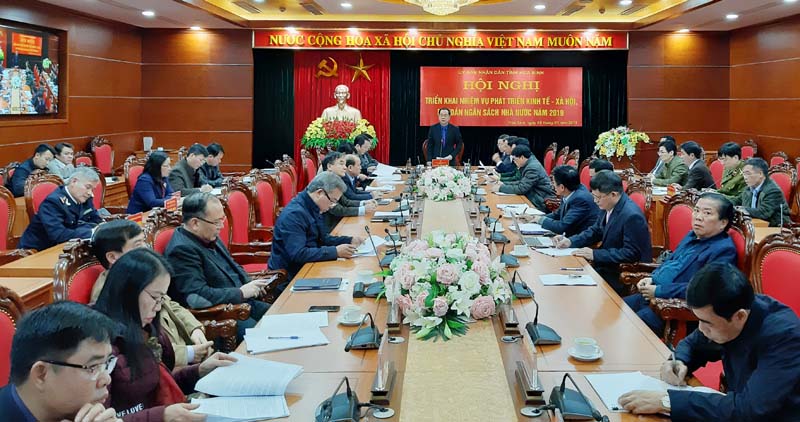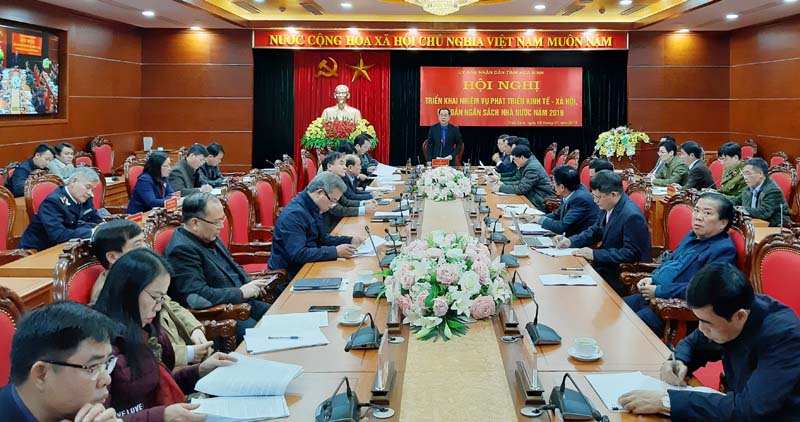
(HBO) - Deputy Secretary of the Hoa Binh Party Committee and Chairman of the provincial People's Committee Nguyen Van Quang chaired an online conference held by the provincial People’s Committee on January 9 to launch the plan of direction and management over the implementation of socio-economic tasks and State budget projection for 2019. The event also focused on realising the plan to implement Resolution 02/ND-CP on continuing to major tasks and solutions to improve the business environment and competitiveness in 2019 with a vision to 2021.

An overview of the conference.
Participants approved a draft plan of direction and management as well as
budget projection for 2019, along with a plan to improve the business
environment of the province.
The plan defined 2019 as a particularly important year for accomplishing
the missions set by the 12th Party Congress resolution and the resolution of
the 16th provincial Party Congress, as well as the 5-year
socio-economic development plan for the 2016-2020 period.
Major targets of the province include an economic growth of 9.5 percent,
including an expansion of 4.5 percent in agro-forestry and fisheries sector,
13.28 percent in the industry-construction, and 7.9 in the service sector.
In the economic structure, the agro-forestry-fisheries sector is expected
to make up 20.64 percent, industry-construction 50.02 percent, and service
sector 29.34 percent. Per capita gross regional domestic product (GRDP) of the
province is set to reach 55.1 million VND (2,369 USD), total social investment
16.43 trillion VND, total budget collection 3.81 trillion VND, export turnover
790 million USD, and import revenue 636 million USD.
The province also aims to establish 535 new enterprises and cooperatives.
Urbanization rate is set to reach 23.1 percent, and the ratio of poor
households is hoped to decrease by 3 percent.
Regarding the plan to improve the local business environment, the province
will continue to create a smooth, transparent, fair and friendly atmosphere for
businesses to operate effectively and attract more investors with high capacity
to tapping the province's potentials and advantages.
Specifically, Hoa Binh will strive to increase the total provincial
competitiveness index (PCI) score by 2-5 points compared to that 2018, while
improving component indexes such as market entry costs, land access costs,
unofficial costs, fair competition, dynamism, business support and legal
institutions, bringing them to a level equal to the national average./.
Hoa Binh province is undergoing a dynamic transformation amid Vietnam’s national digital transition. Building on Poliburo’s Resolution No. 57-NQ/TW on breakthroughs in science, technology, innovation, and national digital transformation, the province has rolled out a wide range of practical action plans. A standout initiative is the "Digital Literacy for All” movement, an effort to ensure that no one is left behind in the digital era.
Hoa Binh province is undergoing a dynamic transformation in the wake of the national digital transformation movement. Building on Resolution No. 57-NQ/TW of the Politburo on breakthroughs in science, technology, innovation, and national digital transformation, the province has implemented a wide range of practical action plans. A standout initiative is the "Digital Literacy for All” movement ambitious effort to ensure that no one is left behind in the digital age.
With a spirit of unity and proactive problem-solving, the Party Committee, the government and the people of Dong Lai Commune (Tan Lac District) have made great strides in implementing the resolutions of the 24th Party Congress of the commune for the 2020 - 2025 term. Focusing on leadership and practical actions, the commune has brought the Party’s resolutions into daily life, creating strong impacts and pushing the local development forward.
Amid the nationwide push for digital transformation, young people in Hoa Binh Province are stepping up as dynamic pioneers, applying technology to enhance Youth Union operations and expand the reach of youth-led initiatives. Through creativity and adaptability, Youth Union organizations at all levels have introduced a series of practical solutions, contributing to modern governance and community development.
In recent years, An Nghia commune, located in Lac Son district, has stepped up administrative reform, focusing on improving the quality and efficiency of its single-window service unit for receiving and processing administrative procedures. These improvements have helped create favourable conditions for local residents and organisations to handle administrative procedures, contributing to the commune’s broader socio-economic development.
The Prime Minister-approved master plan to develop the multi-use value of forests ecosystems through 2030, with a vision to 2050, aims to improve the management and sustainable use of forest resources, create jobs, increase incomes, and improve the living standards of ethnic minorities, people in mountainous and remote areas, forest workers and those living near forests.



